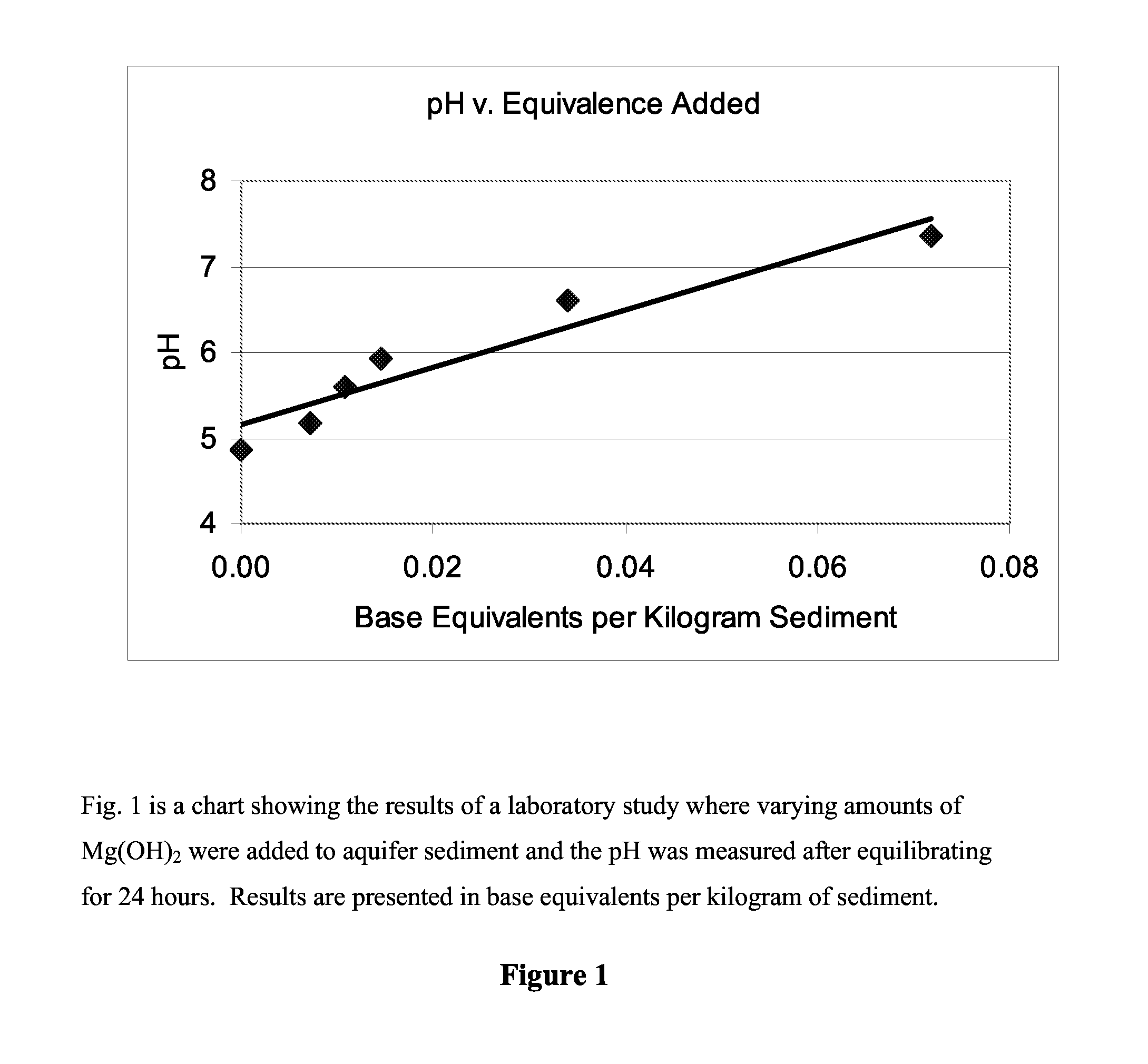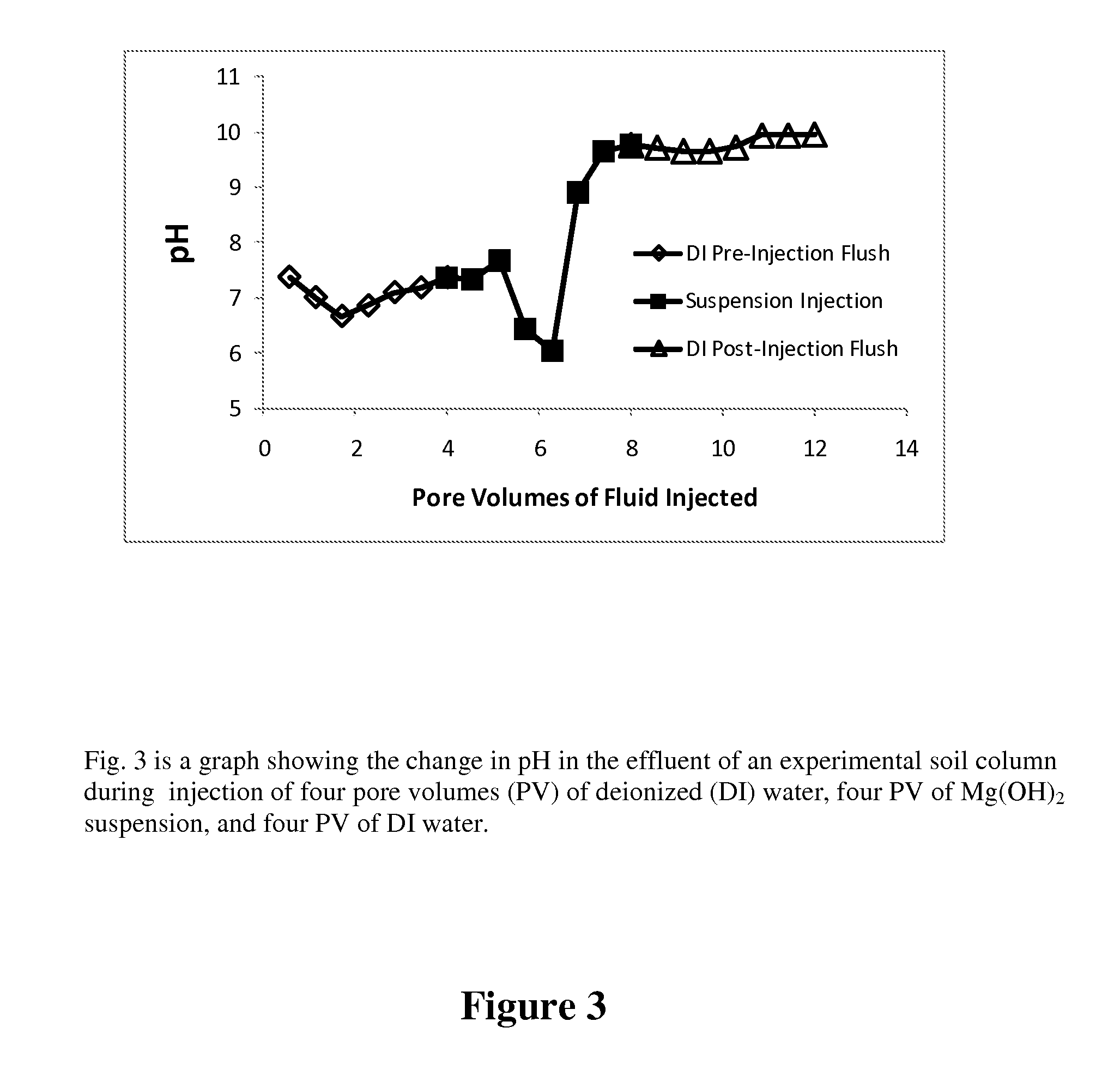In situ ph adjustment for solid and groundwater remediation
a technology of solid and groundwater remediation and in situ ph adjustment, which is applied in water cleaning, chemistry apparatus and processes, construction, etc., can solve the problems of difficult to achieve high ph levels, reduced reaction rates, and inability to adjust the ph level in situ,
- Summary
- Abstract
- Description
- Claims
- Application Information
AI Technical Summary
Benefits of technology
Problems solved by technology
Method used
Image
Examples
example 1
Field Demonstration of Buffering on Aquifer pH
[0101]A pilot study was conducted to evaluate the use of emulsified oil substrate (EOS®) for the bioremediation of trichloroethylene (TCE) in a prototypical source area. The depth to ground water at the site was approximately 6 feet below ground surface (ft bgs). The subsurface material at the site consisted of 5 to 8 ft of silty sandy clay underlain by 8 to 10 ft of silty sand, with dense clay acting as a lower confining layer at approximately 16 ft bgs. The hydraulic gradient of the area was low (˜0.001 ft / ft) and groundwater velocity was also low (˜5 ft / yr). The hydraulic conductivity varied from 1 to 3 ft / d. A field pilot test had previously been conducted at this site to evaluate the use of emulsified oil alone to stimulate anaerobic biodegradation of TCE. However, this previous pilot test was not successful due to the low pH of the treatment zone. Samples of subsurface material collected 15 months after the initial emulsified oil i...
example 2
pH Adjustment to Improve In Situ Aerobic and Anaerobic Bioremediation at a Hazardous Waste Site
[0116]A large hazardous waste site was contaminated with a complex mixture of organic contaminants including aromatic hydrocarbons (benzene, toluene, ethylbenzene, xylenes), chlorobenzene, dichlorobenzene isomers, acetone, methyl ethyl ketone, 4-methyl-2-pentanone, 1,1,1-trichloroethane, cis-1,2-dichloroethene, chloroform, 1,2-dichloroethane, 1,1-dichloroethane, methylene chloride, tetrachloroethene, and trichloroethene. Laboratory microcosm studies demonstrated that all these pollutants could be biodegraded using a sequential aerobic-anaerobic treatment process. However, during the aerobic phase, the pH dropped to 5 or less, slowing biodegradation.
[0117]Biodegradation processes could be enhanced at the site by injecting a Mg(OH)2 suspension with a median particle size less than the median pore size of the sediment to increase the pH of the aquifer to between 7 and 8. Oxygen could then be ...
example 3
pH Adjustment for Enhanced Attenuation at a Petroleum Release
[0118]Common groundwater contaminants associated with gasoline and other petroleum releases include benzene, toluene, ethylbenzene, xylenes (BTEX), 1,2,4- and 1,3,5-trimethylbenzene, n-butylbenzene, n-propylbenzene and naphthalene. All of these compounds are known to be readily biodegradable under aerobic and / or anaerobic conditions (Borden, 1994). Numerous laboratory and field studies have shown that these contaminants can biodegrade without human intervention through a process termed “Natural Attenuation”. However, low pH conditions can slow or stop natural attenuation.
[0119]Natural attenuation processes could be enhanced by injecting a low solubility alkaline solid into the aquifer to increase the pH providing conditions more suitable for petroleum hydrocarbon biodegradation. As the solid slowly dissolves over time, it would provide a long term source of alkalinity to maintain a neutral or slightly alkaline pH and enhan...
PUM
| Property | Measurement | Unit |
|---|---|---|
| particle diameter | aaaaa | aaaaa |
| particle diameter | aaaaa | aaaaa |
| viscosity | aaaaa | aaaaa |
Abstract
Description
Claims
Application Information
 Login to View More
Login to View More - R&D
- Intellectual Property
- Life Sciences
- Materials
- Tech Scout
- Unparalleled Data Quality
- Higher Quality Content
- 60% Fewer Hallucinations
Browse by: Latest US Patents, China's latest patents, Technical Efficacy Thesaurus, Application Domain, Technology Topic, Popular Technical Reports.
© 2025 PatSnap. All rights reserved.Legal|Privacy policy|Modern Slavery Act Transparency Statement|Sitemap|About US| Contact US: help@patsnap.com



